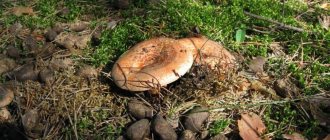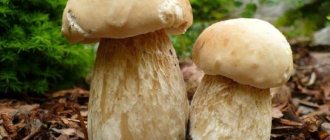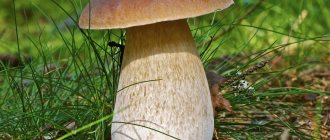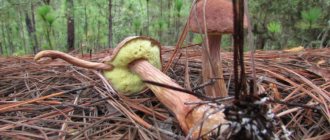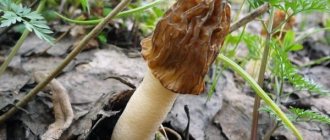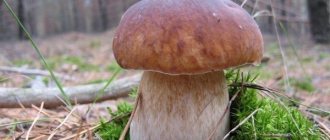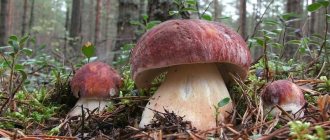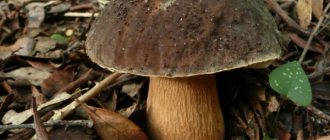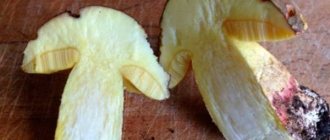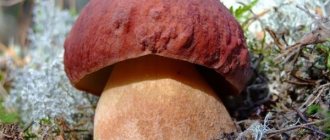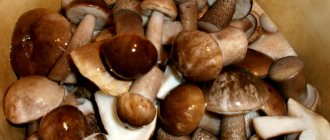The mushroom kingdom has its own king - the Boletus mushroom or the White mushroom. He received this title for a reason. Compared to other mushrooms, Boletus stands out due to its size and taste. It also contains a lot of vitamins and nutrients. Every mushroom picker is happy to find such a mushroom “treasure” in the forest.
The Boletus mushroom grows in almost every forest on the planet except Australia. He prefers the neighborhood of pines, fir trees, birches and oaks.
Description of the Boletus mushroom
Boletus is difficult to confuse with other mushrooms due to its size. His hat grows in diameter from 7 to 30 cm, has a pillow shape, and is smooth or velvety to the touch. The color of the cap depends on the variety and environmental conditions: lemon yellow, orange, reddish brown or purple. The leg reaches a length of 20 centimeters or more, has a thickening in the middle and at the bottom. Its fibrous surface can be smooth or scaly. The inside is white or lemon in color, and the cut is blue, red or white.
Borovik contains several times more nutrients than meat and even more than fish. The mushroom helps the digestive system and increases appetite. It also helps fight many diseases due to the presence of a large amount of vitamins.
What does it look like? Instructions for children of 3rd grade
Despite the fact that the Boletus mushroom most often has a yellow stem and a brownish cap, it is also called White. This is because if you break a mushroom, it will be snow-white inside. It is worth remembering that the color of the mushroom may vary depending on age and species.
- Bronze Boletus grows in mixed forests in southern Russia, where there are pine trees. The mushroom is not large in height, about 12 cm. The stem is bronze-colored, the cap is dark, almost black, up to 17 cm in diameter. It is rare and grows singly.
- The reticulated boletus or White oak mushroom may appear in May. You need to look for it in mountainous areas under oak, less often under beech or chestnut. Borovik got its name because of the cap, which cracks over time and becomes covered with a pattern similar to a mesh. The cap is convex and light brown.
- The Maiden Boletus has a velvety cap of brown-yellow or red-brown color, then it becomes smooth. The leg is shaped like a mace and is covered with a mesh that disappears as it grows.
- Maiden Boletus grows in mixed forests. Prefers proximity to fir trees, calcareous soil and a moderately warm climate.
- Bicolor Boletus grows in North America. The cap and bottom of the leg are painted pink, and the top is yellow.
- Porcini mushroom is a famous and widespread type of Boletus. Grows under coniferous trees and birch trees. The brown cap grows up to 30 cm. The light leg is up to 10 cm in height. The surface of the mushroom is dry, but after rain it becomes shiny.
Popular types of boletus mushroom
There are approximately 300 species in the boletus genus, almost all of them are edible:
- Birch mushroom (white). The skin of the cap is either smooth or has wrinkles; when cut, it remains light in color. A thick, barrel-shaped leg of a light brown color with a white mesh at the top.
- Oak mushroom can be collected over a long period of time (from May to October) in mixed forests. Its cap has a velvety structure and is brown or yellow in color. The leg is stocky and smooth to the touch.
- The maiden boletus can have a brown or red cap with a maximum diameter of 18 centimeters. The leg is usually lighter than the cap, its lower part is pointed.
Boletus mushroom - like a picture in the forest
To find boletus in the forest, you need to prepare: dress warmly and comfortably, take a basket or basket. The boletus must be picked carefully so as not to damage the mycelium. Then next year you can return to this place again to pick mushrooms. If you go into the forest after rain, you can find a lot of Boletus mushrooms, but in hot, dry weather all the mushrooms will hide.
You can meet the White mushroom in the forest from June to October. They sometimes grow alone, and sometimes in large families. Most of all, Boroviki prefer the neighborhood of coniferous trees, but they are also found in deciduous forests. Experienced mushroom pickers advise looking for boletuses in places where there are many anthills, under fallen leaves or dried pine needles. Both young and quite large specimens grow in the forest. The largest Borovik found weighed about 7 kilograms and was 50 cm high.
How and where does boletus grow?
Boletus can grow in almost any climatic conditions, anywhere in the world. It is possible to meet it alone and in small groups in coniferous and deciduous forests at the base of trees. The porcini mushroom does not like wet surfaces and grows on lichen or moss, usually at the base of mature trees.
Having found one specimen, you need to carefully examine the place where the boletus mushroom grows - most often, its fellow mushrooms are nearby.Growing a mushroom at home on your own is accessible and relevant, but this will require a lot of effort, patience and providing it with suitable conditions for growth and reproduction.
It is necessary to first plant trees on the site (spruce, birch or pine), since the boletus is closely related to their roots.
Breeding is available in the following ways:
- The caps of mature specimens are cut into small slices and mixed with moist soil, then laid out under the tree.
- Carefully dug out mycelium from the forest, place it in recesses under the trees and cover it with forest soil on top. The planted mycelium must be watered moderately regularly.
- Finely chop the boletus and soak in water for 24 hours, then strain thoroughly. The remaining infusion, which contains the spores, is evenly poured under the roots of the trees.
Borovik, why is it called that?
There are several points of view regarding the origin of the name of the mushroom.
- Mythological
In ancient Rus', spirits living in the forest were called boletus. They could turn into mushrooms and thus lure travelers into the thicket of the forest. The white mushroom was the most prominent in the forest and most resembled a mythical creature. This is how it got another name.
- Natural
Boletus cannot be found in meadows and fields. Everyone knows that most of all the white mushroom prefer to grow next to pine or spruce trees. Hence the name Borovik - a mushroom that grows in pine forests, in other words, coniferous forests.
Story with pictures, coloring pages and photos for 3rd grade
There are many stories and poems about Borovik. Fairy tales mention the kind spirit of an old man - Borovichka, who helps everyone. Having learned a simple poem, you can easily find Boletus in the forest based on the description.
On a hillock near the path, a mushroom stands on a thick stalk. A little damp from the rain, the porcini mushroom is large and important.
Early in the morning at dawn, in the morning fog, you need to go into the forest to pick mushrooms. No wonder the proverb says: “The first fog of summer is a sure sign of mushrooms.” Near the path, under a pine or oak tree, the Boletus mushroom grows. Since ancient times, Boletus mushrooms have also been called “colonels” because they tower above the rest of the mushrooms, as if they were in command. Much has been written about Boroviki in the stories of naturalists: Sigunov, Strizhev and others.
Cooking and marinating recipes
Boletus mushrooms are used in various dishes. They do not lose their taste when boiled, fried or salted. In some countries they are eaten raw. Porcini mushrooms do not require long cooking or soaking. When boiled, Borovik does not darken, which allows you to prepare soup with light broth from them. Aromatic mushroom soup is prepared according to the following recipe:
Ingredients:
- 1 cup pearl barley.
- 3 medium sized potatoes.
- 2 carrots.
- 1 onion
- 300g mushrooms.
Cook the pearl barley over low heat until the broth thickens. Mushrooms are fried with onions, and together with chopped potatoes and carrots they are sent to the pan with barley. You can add herbs, bay leaf or pepper to taste. After removing from heat, add a spoonful of butter and let it brew for 20 minutes.
Fried mushrooms
Fresh Boletuses do not lose their aroma when fried. There are many such dishes not only in Russian cuisine. For example, you can cook fried mushrooms according to an old Italian recipe.
Ingredients: fresh boletus, flour, oil (preferably olive) Chop the mushrooms and roll in flour. To create crispy mushrooms, place mushrooms in cold water before frying. After frying in a hot frying pan, blot them with absorbent paper. Sprinkle salt or other seasonings on top and serve hot.
Marinated mushrooms
To store boletus mushrooms for a long time, they are dried, frozen, and salted. In cold winter, you can enjoy delicious pickled mushrooms. For this you will need mushrooms, water, vinegar, salt, peppercorns, bay leaf, garlic, cloves.
Before cooking, wash and chop the mushrooms. Place the Boletus mushrooms in a saucepan with salted water. Bring to a boil, drain the water and cook again. Drain the water and rinse the mushrooms with water. For the marinade, boil 1 liter of water with 1 tablespoon of salt and a little less sugar. Add mushrooms, garlic, bay leaf, pepper, 1 tablespoon of vinegar. Let it simmer for a while and pour into jars.
Not only people love to harvest boletus, but also “forest dwellers”. Squirrels dry them by putting them on twigs and branches. Thus, she can prepare almost a kilogram of mushrooms.
Both taste and benefits
White year can be consumed in any form: dried or pickled, salted or fried. This forest delicacy has a delicate and pleasant taste.
In addition to its excellent taste, the mushroom also has useful properties: it saturates the body with nutrients, improves the condition of the skin, hair and nails, has an immunostimulating and anti-inflammatory effect, and is used as a preventive measure for anemia and atherosclerosis.
The therapeutic effect occurs due to the selenium, iron, calcium, riboflavin, phytohormones, lecithin, and vitamins B and C contained in the mushroom pulp.
